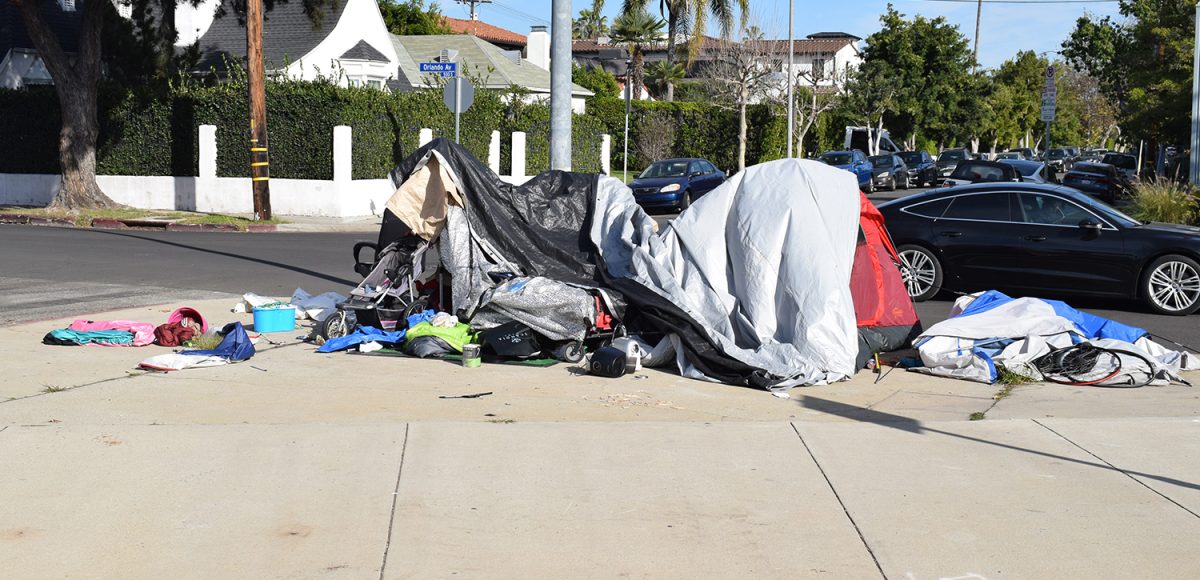Panhandling and camping on public property in the heart of Beverly Hills decreased in 2021, according to a report presented to the Human Relations Commission on Jan. 20. The statistics from the Beverly Hills Ambassador team indicate that camping incidents were down by almost 56%, and panhandling was down 28.5% in 2021. The decrease seems to point toward progress, though December saw more than twice as many aggressive panhandling incidents compared to November, and camping incidents tripled from August to December after a summer low.
“There has been a gradual increase in campers in city structures,” Operations Manager for the Ambassador team Johnathan Hunter said during the Jan. 20 meeting. “On a nightly basis, my team is making contact with these individuals, providing them outreach and then connecting those that are interested in the city outreach services.”
Hunter said the increase in aggressive panhandling in recent weeks has been concentrated near Canon Drive.
“All in all, looking at the year in the whole, the team has done a great job of dealing with all the changes that the triangle has gone through, and continuing to increase their work performance,” said Hunter. The Ambassadors have increased their outreach and hospitality efforts to connect homeless people with services and housing, he added.
Created in 2015, the Ambassadors are contracted through Block by Block, a specialty security firm that provides this type of service to business districts throughout the U.S. The Ambassadors focus their efforts on the Business Triangle and Beverly Gardens Park.
Fewer than 20 Beverly Hills residents are homeless, according to the most recent count by the Los Angeles Homeless Services Authority (LAHSA) in 2019, but neighboring districts in the City of Los Angeles are home to thousands of unhoused people.
While the total population of homeless residents in Beverly Hills is low, Los Angeles encampments, like those frequently seen on Burton Way and San Vicente Boulevard, lie just outside the Beverly Hills city limit.
“Look at Burton Way,” said Chief of Police Mark Stainbrook at a Jan. 25 Recreation and Parks meeting. “If you look at the dividing line between LA and us, you see a very different side of Burton Way on their side, and then you look at our side… What [Beverly Hills] has is common sense policies, common sense resolutions that limit the issues.”
Police officers are in frequent contact with homeless residents, but Stainbrook told the commission the homelessness crisis has largely been taken out of police hands.
“Over the last ten years, homeless advocates have done a really good job with court cases and with laws to try to decriminalize homelessness, which I think is fine,” said Stainbrook.
A controversial anti-camping law went into effect in the City of Los Angeles in September. With that ordinance, a section of Holt Avenue at Burton Way has been proposed as a no-camping zone, and Burton Way medians were recently cleaned up under a separate LA ordinance regulating medians.
Enforcement of LA’s no-camping ordinance has been slow going as it requires an LA City Council vote for each location before camping can be prohibited at a site. The ordinance is also narrowly focused on prohibiting camping near what it calls sensitive sites. These include libraries and schools, and spaces in the public right-of-way like sidewalks. Freeway underpass encampments that block the sidewalk and force pedestrians to walk in a traffic lane are likely to be top enforcement targets.
While numbers on Beverly Hills’ homeless population appear to be improving, a definitive count of the population is overdue after being canceled for the last two years amid COVID-19 concerns. The 2022 LAHSA homeless count, scheduled for this week, was postponed until February in light of the omicron-fueled spike in hospitalizations this winter. Beverly Hills is now slated to have its count on the night of Feb. 23 along with the rest of West Los Angeles County. Results are expected to be made public in the months following the count.







